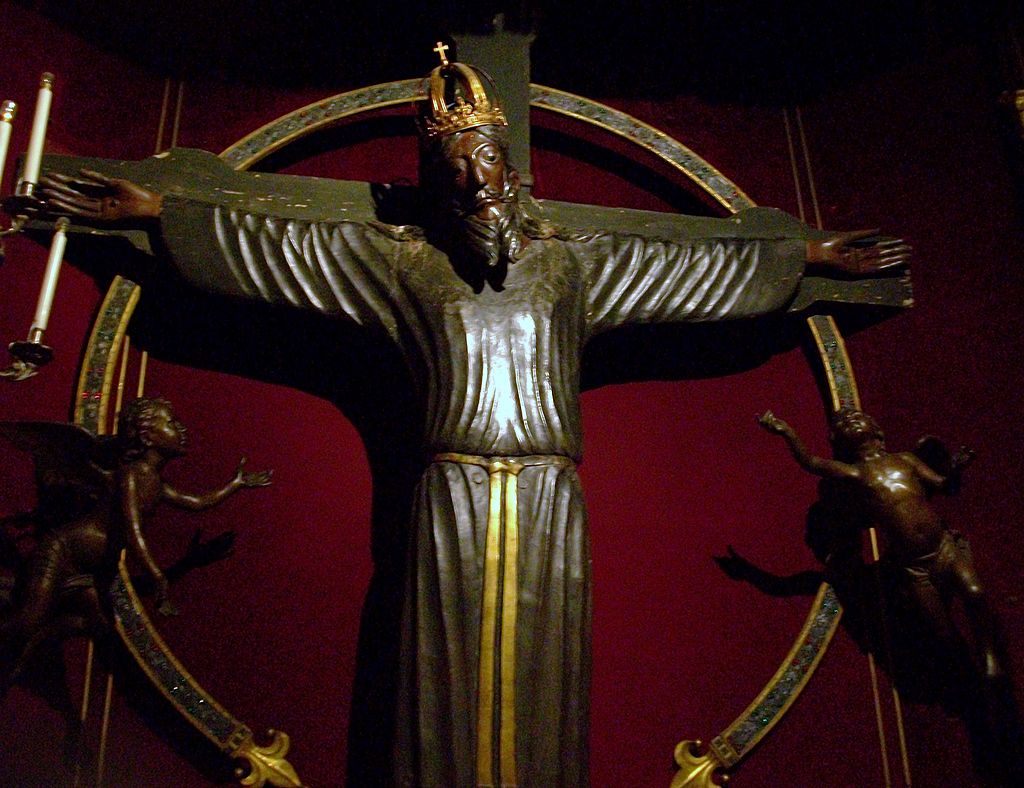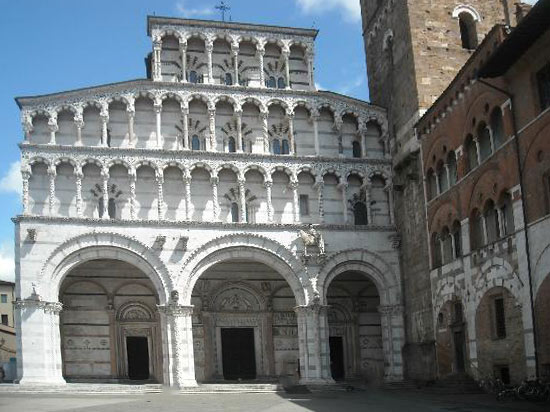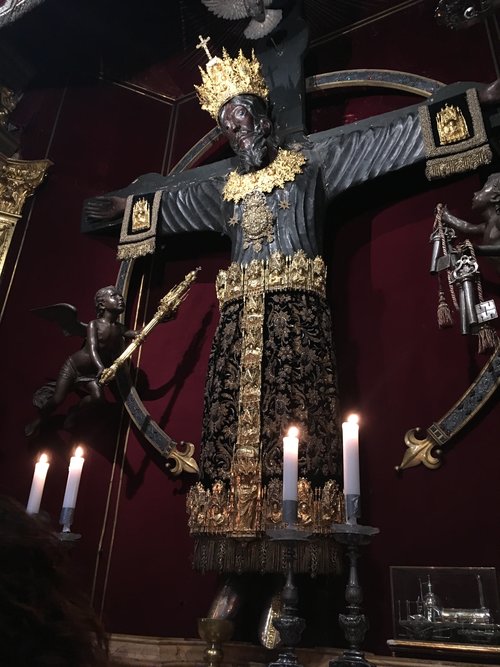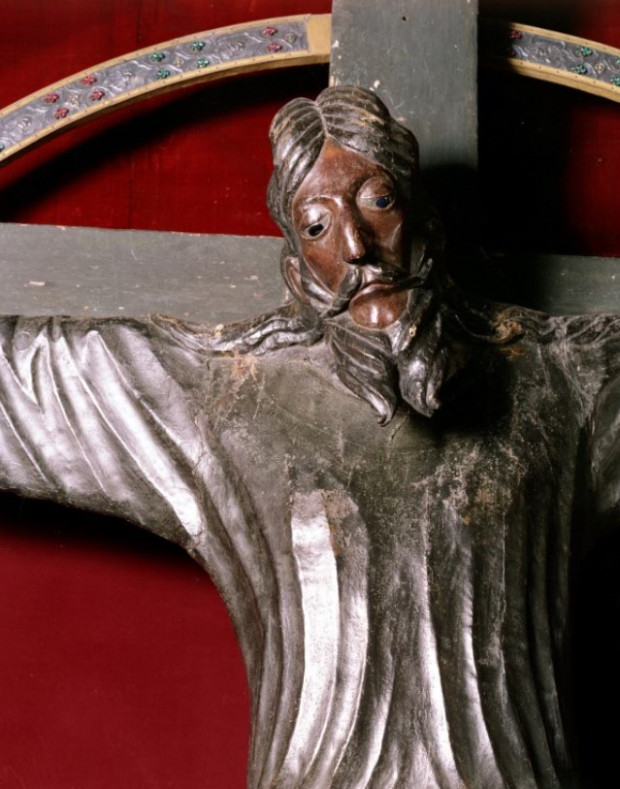Imagine the feelings of the soldiers of the segregated African-American 92nd Infantry Unit after they cleared the Nazi forces out of the Tuscan town of Lucca on viewing the Black Christ of the the Lucchesi in the city’s cathedral. The awe-inspiring black figure crowned with gold, framed by a free-standing ornate marble chapel, is also known as “Il Volto Santo” (“The Holy Face”). Some of those soldiers returned to Lucca on a regular basis to visit the memorable relic.

The Legend
Legend holds that Il Volto Santo, a wooden crucifix, was carved shortly after the resurrection of Christ by Nicodemus, who assisted Joseph of Arimathea in depositing Christ in his tomb. But having carved the body of Christ, Nicodemus fell asleep before carving the face. When he awoke, the face was miraculously completed. Thus, it is deemed to be the true depiction of Christ.
The story becomes even more fantastic in that it claims that the the eight-foot crucifix was then hidden for over 700 years at which time it was discovered, loaded onto an unmanned ship, which set to sea, and eventually landed on the coast of Italy. From there, a cart steered only by oxen brought the crucifix to Lucca where it has remained ever since.

Recorded History
However the wood carving arrived in Lucca, the first recorded account places it in the Basilica of San Frediano in 782 AD. When the new cathedral, Cattedrale di San Martino, was consecrated in 1070, the Holy Face statue was moved there, where it remains to the present day. It became the symbol of the city of Lucca and one of the most revered icons (with attendant miracles) of Christianity, reknown throughout Europe. An uninterrupted flow of the faithful traveling the Via Francigena, the pilgrims’ road between Rome and Canterbury, stopped in Lucca to see Il Volto Santo. In 1087, King William II of England, took a solemn oath in the name of the relic.
Dante, in the 14th century, knew Il Volto Santo of Lucca. Dante wrote in Inferno: Canto XXI of the fifth chasm where embezzlers and thieves serve their sentences. The story is about Martino Bottario, a renowned magistrate in Lucca at that time, who is mocked by devils yelling “here the hallow’d visage saves not,” making it clear to the damned that not even praying to the relic will save him. His damnation will be as eternal as Il Volto Santo. Dante would probably be happy that the crucifix survives to the present day and Martino Bottario still suffers at the hands of the demons of the fifth chasm.
The intricately carved dark wooden crucifix, located in a free-standing octagonal Carrara marble chapel, which was built in 1484 by Matteo Civitali, the sculptor-architect of Lucca. Modern thought was that present crucifix is an early 13th century copy of the original, ascribed to the circle of sculptor Benedetto Antelami. The theory was that the original was chipped away beyond repair by relic-seeking pilgrims. But this theory has recently been proved wrong.
The Black Crucifix is Over 1,200 Years Old
On the occasion of the 2020 celebrations for the 950th anniversary of the creation of the Cathedral of Lucca, the Opera del Duomo of Lucca requisitioned a series of diagnostic investigations on the crucifix of the Black Christ. The tests were carried out with the Carbon 14 method, by the Florence office of the National Institute of Nuclear Physics CHNet – Cultural Heritage Network. Three wooden samples of the sculpture and a fragment of canvas applied on the wooden surface were used for the tests. They gave a striking result: the work can be dated between the last decades of the eighth and the beginning of the ninth century.

It is confirmation that the carving is the first and only Holy Face crucifix, which ancient texts claim to have arrived in Lucca in 782 AD and not a 12th-century work, a replica of an older original that had been lost, as art historians believed until the Carbon 14 tests. In light of the new data, Il Volto Santo di Lucca is the oldest known intact wooden sculpture in the Western World.
Of particular importance for the dating of this extraordinary work is the result obtained from the examination of the linen cloth, placed between the wood and the paint, given that the cutting of a vegetable fiber destined for weaving did not normally precede its processing, while the wood used in the carving could be subjected to a seasoning period after the tree was cut.

The deep brown hue of the sculpture is from a polychrome brown covering over the wood. This was determined in 2013, during restoration of the marble chapel, when non-invasive x-rays and multispectral analysis were performed on the crucifix. Historic documentation reveals that the color was present in the 17th century, but does not say when it was applied.
Currently, in addition to the Carbon 14 tests, the Opera del Duomo in Lucca has commissioned the CNR Institute of Applied Physics in Florence to carry out investigations on the layers of color present on the surface of the sculpture, and is awaiting those results. A survey of the microclimate inside the chapel of the Holy Face is also underway, which for a year will test the humidity and temperature values, fundamental for the conservation of a wooden work.
